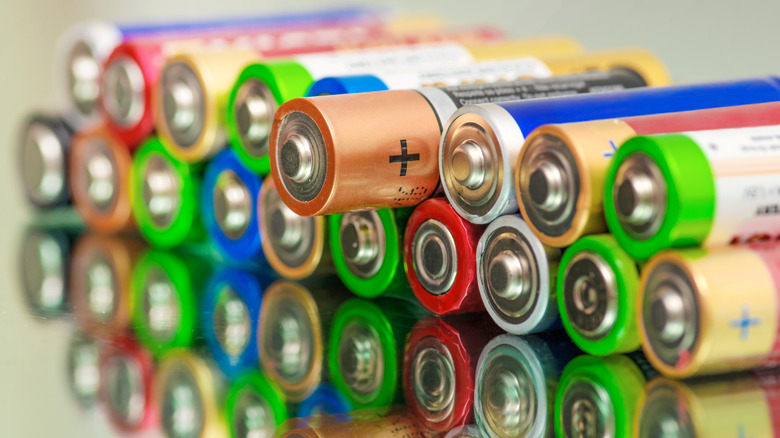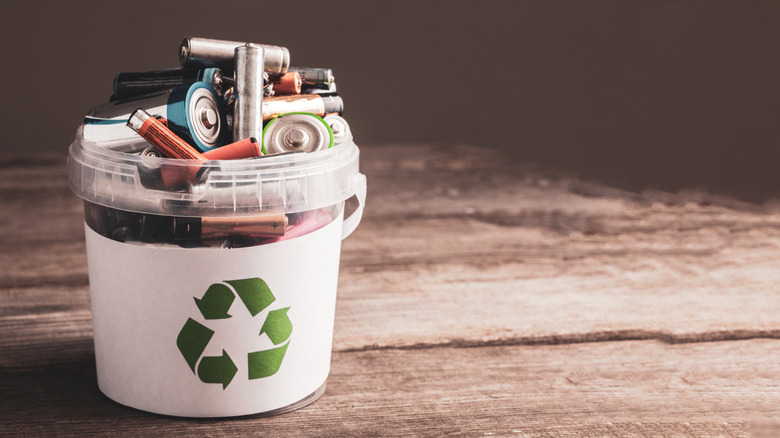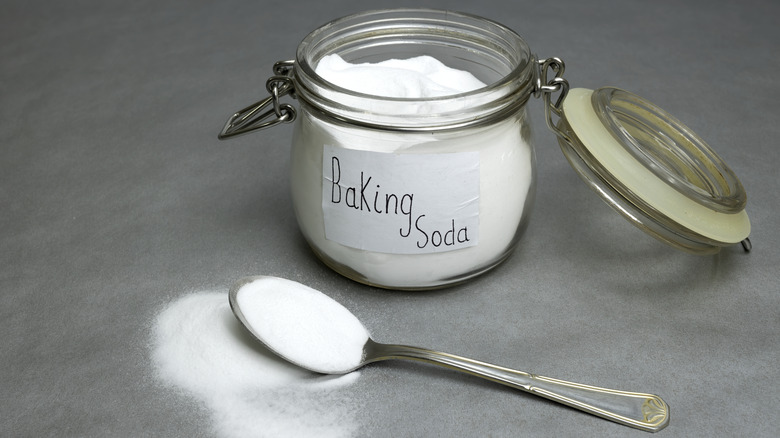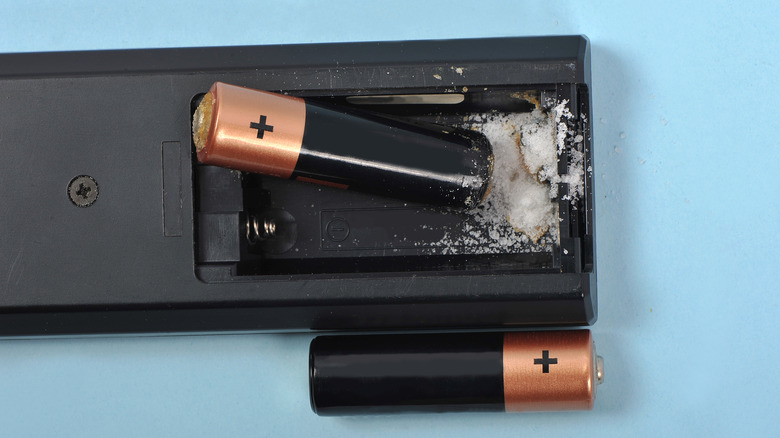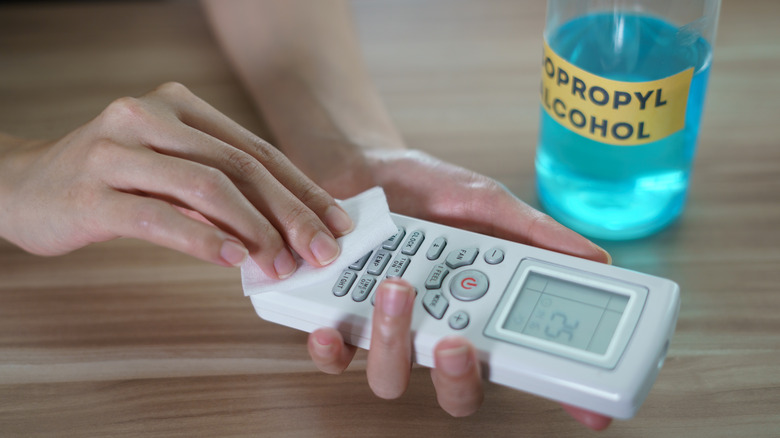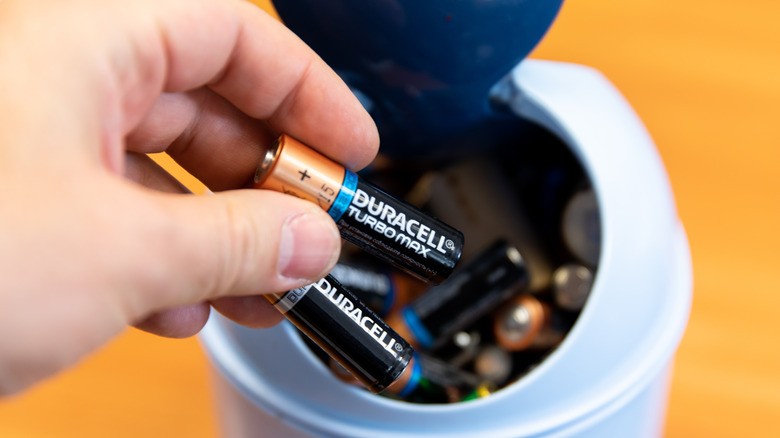How To Clean Battery Corrosion
For centuries, batteries have been used to store and supply stable streams of portable, electric energy. Batteries are able to do this through the chemical reactions that occur within them. These chemical reactions are powered by an external circuit and move electrons between the two sides of the battery. Different types of batteries produce different chemical reactions, which affect the amount of energy the battery can store and the strength of power it can produce, according to the Australian Academy of Science.
The first battery was created in 1800 by Alessandro Volta. Volta was an Italian physicist who studied electrical science (per Famous Scientists). By stacking discs of copper and zinc between clothes soaked in saltwater, he created a stable current of energy, leading to the invention of the battery. Now, batteries, and their many varieties, are used in a wide range of electronic devices, like computers, cars, and even toys (per PHYS ORG). Despite their importance in modern society, damaged and overused batteries can cause corrosion. Grove Collaborative mentions that battery corrosion occurs when a battery leaks its chemical substances, which are highly toxic and can cause a lot of damage when touched or consumed. Luckily, battery corrosion can be quickly and safely removed from your battery-powered items, allowing for continued enjoyment. Helping you keep your home clean and safe, here's how to quickly and safely clean battery corrosion.
Protection while cleaning
Charm City Circulator states that the chemicals within a battery are very harmful substances; therefore, precautions must be taken when coming into contact with them. Specifically, battery corrosion can irritate your eyes and skin if they are not protected and can be very dangerous to your lungs when inhaled. To stay safe while cleaning battery corrosion, gloves, safety goggles or glasses, and a face mask are recommended to be used. Charm City Circulator also recommends cleaning in an area where there is plenty of ventilation to further protect your lungs from the corrosion.
When picking the right gloves to use, Bain's Farm & Fleet recommends using rubber, latex, or nitrile gloves for the best protection for your hands. Safety goggles or glasses work best for this task when they are not shaded because a tinted vision can affect the view of what you are cleaning. To best protect your lungs from acidic gases, use something like this disposal respiratory mask, which reduces odor and exposure to gasses that come from chemical substances.
Removing and disposing the batteries
Before attempting to clean the battery corrosion from anywhere on your gadget or item, you must remove the leaking batteries from their compartment and properly dispose of them. Depending on the amount of corrosion and damage to the batteries, they may be difficult to remove. To protect your hands from the corrosion, HomeQuicks recommends using methods that do not involve your hands when removing the batteries, for example, shaking or prying them out with a screwdriver.
Once the damaged batteries are removed, it's also important to properly dispose of them. Batteries are filled with toxic chemicals. Common Sense Home mentions that when batteries are thrown in the trash and taken to a landfill, they still have the potential to leak and spread their toxic interior into the ground or even to a nearby water supply. Handled improperly, batteries also have the potential of leaking toxins into the air and causing fires or explosions. Different communities have different guidelines when it comes to disposing of used batteries. Ask your trash or recycling company regarding their guidelines or research and find a battery collection center near you.
Neutralizing an alkaline battery
Most batteries that are commonly used around the house contain an alkaline chemical base. This means that an acidic substance can neutralize the chemical and safely rid your item of the dangerous chemical. Vinegar and lemon juice are two natural acidic solutions that are great for these kinds of tasks.
Wirecutter states that you must ensure your device or item you are cleaning is fully powered off, and the batteries are removed before attempting the cleaning process. Then, add a few drops of your acidic solution to the affected area. As you put the acidic solution on the affected area, the corrosion should start to fizz and eventually dissolves. Let your acidic solution work for a couple of minutes before taking a cotton swab, dipped in the acidic solution of your choice, and gently wiping away the corrosion. An old toothbrush can also be used in the place of the cotton swab. Bob Vila recommends checking the area where your device was stored and cleaned to ensure the toxic corrosion is not residing in or on any other objects or place.
Neutralizing an acidic battery
Instead of containing an alkaline chemical base, some batteries have an acidic chemical base; therefore, you will need an alkaline substance to neutralize it, effectively and safely removing your item or device of harmful battery corrosion. The best natural alkaline substance to use for this task is baking soda, according to Funtastic Toy.
When using baking soda as the neutralizing agent, Andrea Dekker suggests mixing the baking soda with a few drops of water to make a paste. Similar to neutralizing an alkaline base, ensure your device or item is fully powered off with the batteries removed before you attempt the cleaning process. When you are ready to clean, take a cotton swab, cover the tip in the baking soda paste, and rub the paste over the affected area. As you rub, the corrosion should begin to remove from the surface. Once the area is clean, allow it to fully dry before placing new batteries in the compartment and putting the item back into use again.
Stubborn corrosion
When batteries leak, the corrosion tends to stay within the battery compartment. Although this keeps the toxic substance contained before you have the chance to clean it, there are a lot of hard-to-reach spaces within that area. This means that when you start the neutralizing and cleaning process of the battery corrosion, those hard-to-reach places may not be affected by those processes. When the corrosion crystallizes, it becomes even harder to clean; therefore, Bob Vila recommends using specific tools to push and scrape stubborn corrosion out of those hard-to-reach areas. The tools to use include a toothpick, tweezers, a pencil eraser, or sandpaper.
After neutralizing and clearing away as much corrosion as possible, allow the cleaned surface to dry before locating the stubborn patches of corrosion. Then, choose your tool of choice and chip away the corrosion until it is completely gone. For corrosion that is stuck on the contacts within the battery compartment, Bob Vila specifically recommends using sandpaper to gently scrape the corrosion away without damaging these important parts. Throughout the process, wear gloves and avoid touching the corrosion with bare skin.
Finish with isopropyl alcohol
While solutions like lemon juice, vinegar, and baking soda can successfully neutralize and clean battery corrosion, they can leave behind residue that can affect the ability of your device to function properly; therefore, to avoid future problems, the residue should be cleaned. Wirecutter states that isopropyl alcohol is perfect for cleaning electronics because it is safe, effective, and dries very quickly.
When finding isopropyl alcohol to clean your device, Wirecutter recommends finding the purest form, which contains 90% to 99% alcohol. The more alcohol that is in the solution, the safer it is to use on internal areas of your gadget. Most first-aid kits are equipped with isopropyl alcohol that contains 70% alcohol. Although this solution is still great for cleaning the outside areas of your gadgets, it should still be used with precaution when cleaning a gadget's inside areas. When finished cleaning, always ensure the cleaned areas are completely dry before putting them back into use.
How to prevent battery corrosion
Battery corrosion is a common occurrence for battery-powered gadgets and items. Funtastic Toy states that it can be caused by for a variety of reasons. In extreme temperatures, batteries tend to react differently, which could cause corrosion. This can happen in extremely hot or extremely cold environments. Keeping the item in a humid or wet place could also cause corrosion. If batteries sit in an unused gadget or item for a long period of time without being changed, they are also prone to corrosion.
To avoid corrosion, Bob Vila recommends not using batteries past their expiration date. This means frequently changing batteries in your items and gadgets, as well. You should also avoid mixing old batteries with new batteries. When your old batteries are empty, put them in a separate container to be properly disposed of. Most of all, store your batteries and battery-powered devices in a controlled environment. This means keeping them away from extreme temperatures and in a dry environment.
